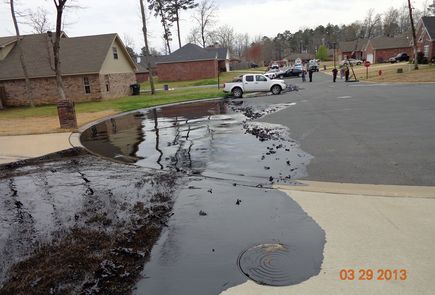
Oil spill face courtesy of Julie Gibbons.
Residents in the Atwater Village neighborhood of Los Angeles woke up on May 15 to a foul odor and streets covered in oil. An estimated 10,000 gallons of oil stretched across a half-mile area, with reports of oil knee-deep in some areas.
The spill was caused by a pipe bursting in an industrial area of Atwater Village. Officials with Plains All American Pipeline, the company that owns the line, said the pipe break was caused by a valve malfunction at the Atwater pump station. The pipe suffered a 20 inch break that sent oil shooting into the air and onto nearby buildings and streets.
While environmental crews worked quickly, the smell lingered for more than a day, and residents were instructed to leave windows and doors open to keep their homes properly ventilated.
This oil spill of course isn’t the first to happen, and it won’t be the last. Industry analysts claim that pipelines are quite safe if they are maintained and operated properly, but there are always risks. For years we have analyzed the effects of environmental contamination, including such disasters as the Exxon Valdez oil spill in Prince William Sound, Alaska; the Murphy Oil spill in St. Bernard Parish, Louisiana associated with Hurricane Katrina; and the Deepwater Horizon incident in the Gulf of Mexico. Any project involving the extraction, storage, or transport of hazardous materials has the potential to cause problems.

Photo of the Mayflower oil spill courtesy of the U.S. Environmental Protection Agency.
While the cleanup in Atwater happened quickly, this oil spill is a good reminder that spills are not just limited to the ocean. They can happen on land too, and any spill can cause considerable damage. Workers acted quickly in Los Angeles, but the consequences could have been much worse.
The full impact of the Atwater spill probably won’t be known for some time, and it’s one of several that have occurred in residential or commercial areas in recent years. Last year, an ExxonMobil pipeline carrying Wabasca Heavy Crude from the Athabasca tar sands in Alberta, Canada ruptured and spilled at least 210,000 gallons of oil in a residential street of Mayflower, Arkansas. The spill required the permanent evacuation of 22 families, and several lawsuits are in progress in the matter.
This oil spill comes at a time when politicians are debating the Keystone XL Pipeline project, an undertaking that would transport oil from Alberta, Canada to Nebraska. A decision on the Keystone XL Pipeline has been delayed, perhaps not coincidentally, as both political parties prepare for the November elections. As the contentious project continues to be debated, each new spill seems to heighten public awareness of the issues surrounding oil extraction and transportation.





Recent Comments